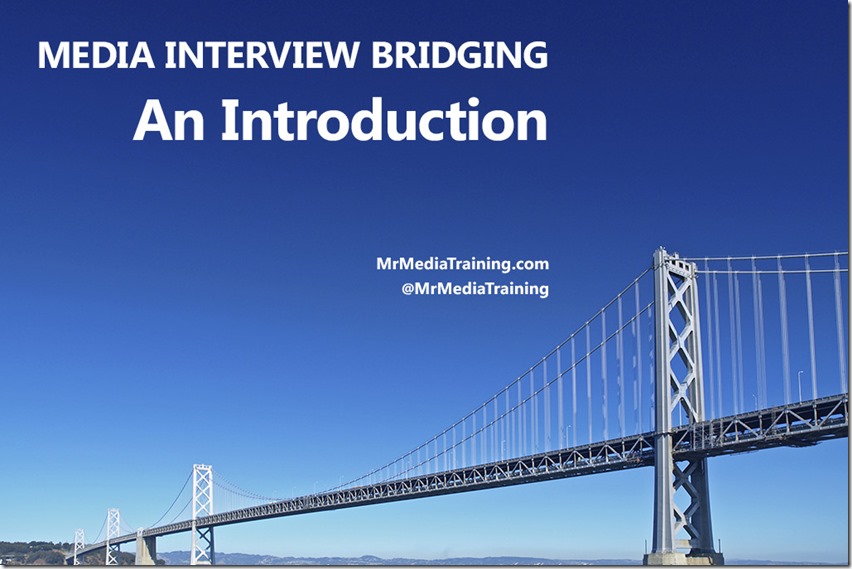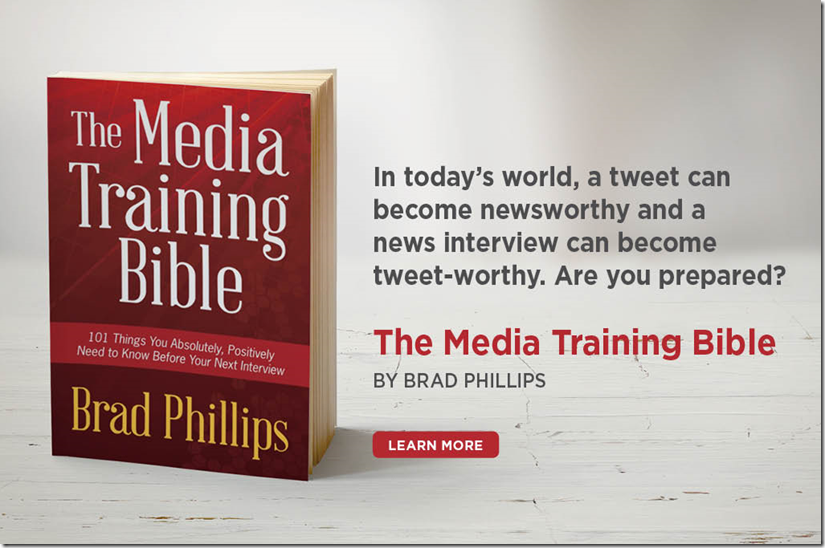Media Interview Bridging: An Introduction
Despite publishing more than 1,200 blog posts, we’ve never done a deep dive on how to “bridge,” or transition, during a media interview. I’m not sure how that happened!
Over the next month, I’ll correct that oversight and publish a series of articles about bridging that teaches you how to transition from a reporter’s question back to your message effectively (see the bottom of this post for links to the rest of this series). Along the way, you’ll find more than a dozen transition lines, see several examples, and read why I disagree with those who argue bridging isn’t as useful as it used to be.
In this first article, I’ll discuss what a bridge is and when to use one.

Too often, media guests allow themselves to be led through interviews by reporters. The interviewee, eager to please the journalist and create a favorable impression, simply follows along as the journalist darts from topic to topic.
While that may sound like a logical way to proceed with an interview, the problem is that too many spokespersons never get the opportunity to say the things they most wanted the audience to know about their topic.
Sure, once in a while, the reporter will ask them the “perfect” question that allows them to deliver their messages, but that doesn’t always happen. Good media guests don’t expect or wait for the so-called “right” question to be asked before getting their messages across. They use a bridge to help them get from the reporter’s question to their messages.
Bridging is also a critical technique to help you respond to off-topic, difficult, or hostile questions. If you do nothing but respond to skeptical questioning during an interview, your responses may come across as defensive. Worse, they may fail to contain the more useful information that will inform, persuade, or motivate your audiences.
You’ve surely heard hundreds of bridges from experienced media guests while watching television or listening to the radio. They include:
“The most important thing to remember is…”
“That’s not what we’ve been hearing from our customers. What we’ve been hearing from them is…”
“That said, what we see as an even bigger threat is…”
You might be wondering if bridging is intended to be a dodge. It isn’t. Media guests who refuse to answer direct questions are often punished by members of the audience who resent the interviewee’s evasiveness (that’s especially true during live interviews, when viewers or listeners can hear or see the full exchange).
Rather, a good transition generally follows a direct response. That response can be short; a single word or phrase is often sufficient. Here are a few examples of answers that might precede a transition:
- “Yes.”
- “No.”
- “Maybe.”
- “Perhaps.”
- “That’s not what our research shows.”
- “That’s unclear.”
- “Some of the time, but not all of the time.”
Once you’ve offered that direct response, you can use a transition line to bridge to your message. (I describe a more complete version of my trademarked technique called “The ATMs” in The Media Training Bible: 101 Things You Absolutely, Positively Need to Know Before Your Next Interview.)

Bridging: An Example
Let’s say you represent an environmental nonprofit working to protect the American crocodile in Florida. Many local residents are upset with your proposal for a conservation area because they fear your group is prioritizing the crocodile over the concerns of nearby residents.
The message you want to get across is this:
“Protecting the American crocodile will help local residents and their families earn a better living, as the increase in ecotourism will significantly boost local business.”
Here’s the reporter’s question:
“Isn’t there inevitably going to be conflict whenever environmentalists propose a new conservation area that impacts local residents?”
If you don’t use a bridge to answer that question, your entire response will be about the conflict between environmentalists and local residents, which does little to advance your message. Using a bridge allows you to answer the question directly first—and then go straight to your message.
[Answer] “There doesn’t have to be. [Bridge] What I hope nearby residents will keep in mind is that [Message] protecting the American crocodile can help people in the area earn a better living, as the increase in ecotourism will significantly boost local business. We know this because three years ago, residents in Miami were also nervous about a new conservation area—but we now know that the people living next to that area actually saw an increase in their household income.”
One final note: Save your bridges for moments that matter. If you use too many of them in a single interview, the device itself could come across as obvious and inauthentic.
Read The Rest of This Series
Part Two: Media Interview Bridging: Sample Bridge Lines
Part Three: Media Interview Bridging: Three Examples
Part Four: Media Interview Bridging: Two Good Video Examples
Part Five: Media Interview Bridging: Is Bridging an Outdated Practice?



